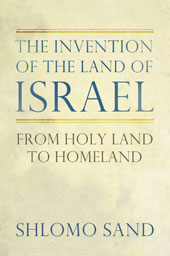(This is a crosspost from Fathom.)
Shlomo Sand, The Invention of the Land of Israel, From Holy Land to Homeland, translated by Geremy Forman
Verso, London & New York 2012, 295 pp.
Shlomo Sand’s political treatise, The Invention of the Land of Israel, is another link in his larger project of deconstructing the ‘historical super mythos of the Jews as a wandering people’ and severing the bond of memory between the ancient Land of the Patriarchs and the modern Jewish experience. After having proved to his satisfaction in a previous book that the Jews are not a ‘people,’ the author sets out to demonstrate in this volume what every researcher of nationalism knows and what all researchers of Zionism stipulate: the Land of Israel as a geopolitical concept was born only in the modern era.
The treatise opens with an autobiographical chapter. In an anguished personal confession, the Tel Aviv historian reconstructs horrifying and, at times, ridiculous encounters between a sensitive young man and the ugly facets of Israeli ultra-nationalism, as it existed fifty years ago. The way Sand couples his doings as an Israeli soldier and a nefarious act of murder and plunder by scofflaw Israeli soldiers, which he witnessed in the 1960s, with the Zionist enterprise of reconnecting the Jews with the ancestral land is a rather simplistic device worthy of a political propagandist. Indeed, crimes were (and, one fears, will be) committed in Israel’s wars by power-intoxicated and avaricious criminals. I do not, however, remember a single war in the twentieth century, whatever its ideological justification that did not witness similar events, nearly always on a larger scale and with a far ghastlier human toll.
Sand moves directly from his account of these manifestations of extremism – negligible events in the history of the defensive war against the Arab states’ armies that invaded Israel territory in 1948, and anomalous in the Israeli political landscape of the time – to a critical discussion of Jewish nationalism at large. For Sand, Zionism per se, all its factions and currents, is of one cloth with the most eccentric fringes of Israeli ultra-nationalism. The conclusion he expresses in his autobiographical introductory chapter, even before he offers a word about the historical sources, is clear and razor-sharp: Zionism, a reprehensible and power-thirsty movement, seized control of the minds of members of the Jewish religious community in the modern era. It stripped the believers of Jewish values, including remembrance of their ancient ancestral land for the sake of a nefarious, cruel and unjustified project: the forcible reclamation of the land in a process of secular nature.
Historiographical Investigations
The Invention of the Land of Israel speaks on two levels: historiographical investigation and political interpretation. To fully appreciate the nature of Sand’s political treatise at hand, the reader must grasp how these two levels exist in tension with each other, often sending out diametrically opposing messages.
While the book is packed with historical information and contains lots of citations, as a veteran researcher of the history of the Jewish national liberation movement, I was surprised that it is hard to find even one research novelty in anything Professor Sand says. The book adds no new knowledge, historical insight or perspective that has not been presented before in regard to the changes that occurred in the Jews’ connection with this piece of land. Furthermore, purely on the investigative level of Sand’s work, I was unable to discover any factual statement that Zionist historiographers or prominent thinkers of the national movement would not also stipulate. The historical account that Sand offers is generally speaking true to the conventional wisdom of the old Zionist historiography.
Here, in Sand’s thinking, is what happened to the Land of Israel in Jewish history: Until the destruction of the Second Temple in 70 CE, the territory of today’s State of Israel was not perceived as ‘the Land of Israel’. The expression Eretz Yisrael, the Land of Israel, was coined only in post-biblical literature; it was the Babylonian Talmud that created the link between Jewish faith communities and the land and imparted an anti-territorial outlook to generations of Jewish believers. Mystical outlooks that amassed enormous influence in the Jewish religious world in the early modern era did away with (or at least diminished) the centrality of Land of Israel in its geographic sense. Visiting the Holy Land, and a fortiori settling there, was a marginal practice in Jewish communal life until the early modern era. In the modern era, anticipation of the ‘return to Zion’ in Protestantism, especially in its British version, was central in reconnecting the Jews with the material Land of Israel. Two modernistic religious currents (Orthodoxy and Reform) categorically rejected the idea of the Land of Israel as a Jewish possession, a destination for mass immigration or the historical national homeland. Zionism wrought an unprecedented revolution in the nation–land nexus: it nationalised the Jewish religious discourse, transforming the Holy Land into a national territory, namely, the ‘Land of Israel’.
Anyone who is well versed in the rich research literature on the Land of Israel and its history, and relates only to the historiographic level of Sand’s book, may mistake it for just another old-fashioned ‘Zionist’ work, somewhat conservative and rather weakly related to the current state of research. For example, the claim that the Zionists nationalised the Jewish religious discourse and transformed holy soil into national territory –‘the Land of Israel’ – was agreed and accepted (to differing degrees) by almost all producers of the foundational texts that line Zionist bookshelves, not to mention several generations of Zionist historians. Is there anyone in Israeli academia (after all, Sand is a professor of history at a leading Israeli university) who does not know that the pioneers of the Jewish national movement, keen to rebel against the Talmudic legacy and the kabbalistic spiritualisation of the Land of Israel, recruited the Bible for a revolutionary venture in national culture under the influence of Protestantism? They laid hands on the age-old treasures of the Jewish religious corpus, extracted various concepts and insights from it and coupled them to a new national narrative. Zionist activists were well aware of the relations that existed between British and other Christian millennialists and the Jewish intellectuals who are known as the ‘forerunners of Zionism’ – a connection that Zionist historiography has researched up, down, and across for generations.
However, the Zionist innovators, unlike Shlomo Sand, did not consider their venture and political culture a forgery, a lie or a propaganda trick. On the contrary, they viewed it as an exalted act – the systematic uncovering of a historical truth that the rabbinical elite had concealed from the Jewish masses by silencing it and banishing it from conscious thought. The rediscovery of a real country with hills, vales, rivers and shores in ancient texts played a definitive role in the cultural endeavors of several preeminent Zionist thinkers. Izhak Ben Zvi and David Ben-Gurion ‘translated’ biblical and Talmudic geographic information into geopolitical concepts, à la European nationalism, and created a cultural infrastructure for the concretisation of the boundaries of the Zionist settlement project. Sand does relate to the geographic and historical project of these two socialist leaders but tosses in a pronouncedly ahistorical remark that links their book, Eretz Israel, with early 21st-century European colonialism. Nevertheless, by producing this book, Ben Zvi and Ben-Gurion made their contribution to the Zionist ‘Ingathering Project,’ a far-reaching cultural endeavor that its progenitors considered a vehicle that would link the intellectual assets of the past with the modern national enterprise. The idea behind this project, which Sand evidently considers yet another product of Zionist mendacity, was to provide the Jews with an alternative way of remembering the past. While embodying a rebellion against the past, it also offered much continuity. Obviously, the ultra-Orthodox Jew who adhered to the old world of faith, along with the liberal who wished to rupture for good his irksome link with the disturbing and embarrassing memory of a distant and unfamiliar land, were partners in their opposition to the dual-edged Zionist uprising: against both the ancient legacy and the contemporaneous universalism. In the historiographical part of his work, Sand describes accurately (albeit sometimes in a simplistic manner that overlooks the complexity of the cultural processes that modern nationalism instigated in Jewish society) the contours of this Zionist uprising.
Political Interpretations
At the political and ideological level of the book, Sand passionately identifies himself with Zionism’s opponents – the ultra-Orthodox and the liberals –from the late 19th century all the way into the early 21st. But what is Sand’s revisionist deconstruction of the Zionist discourse on both the Jewish people and the Land of Israel opposing, exactly? The answer is by no means clear. While Sand repeatedly mocks Israeli historians, whom he views as agents of Zionist falsehoods, he also accepts without challenge the contours of the historiography that they created. His onslaught has a different target: the popular myth, common in certain Israeli circles, about the existence of a direct relationship between the biblical Land of Israel and the piece of land that the modern Jewish national movement settled.
Time and again, while Sand repeats almost verbatim the Zionist historians’ analysis of the past, he insists nonetheless upon ‘the invention of the Land of Israel’ by adopting a theoretical framework about nations and nationalism that is drawn from the work of Eric Hobsbawm, the renowned researcher of nationalism. Since Hobsbawm wrote that there is no justification for identifying the Jewish connection with the Land of the Patriarchs with the goal of gathering all Jews into a new territorial state in the ancient Holy Land – by which the eminent British historian revealed his utter disinterest in the cultural aspects of the Jewish national movement – no few scholarly studies have been published about the relation between ancient religious traditions and modern national movements. A rich literature has been produced on the complex patterns of continuity and discontinuity between past legacy and modern culture, and questions asked about how new the various ‘invented’ traditions really are, looking to the past for roots, omens and beginnings. However, Sand remains stuck in an outmoded academic school, unable to imagine that the historical consciousness of modern thinkers has always been troubled by the question of the connections between modernity and its precursor.
In sum, Sand’s book illuminates the metamorphoses of the Zionist struggle to impress on members of an ancient people a renewed and revolutionary connection with a homeland, the memory of which had been maintained for generations in collections of books, festival rituals and prayerbooks. Alongside that sits the author’s seething hatred of Zionism, and everything associated with it, and this prompts him to present the struggle of the Jewish national movement as a set of falsehoods, distortions and prejudices. The critical reader finds the perpetuation of the basic outlines of secular Zionist thinking and the rejection of those same outlines politically, as the author careens from an Orthodox anti-Zionist point of view to radical European Enlightenment-style anti-nationalism and back again. These two extremes, against which Jewish national thinking rebelled from its outset, delegitimised (and are still delegitimising) the historical and cultural relation between the Jews and the Land of Israel. Like those two extremes, the author of The Invention of the Land of Israel also vehemently rejects any connection with the land that is not ‘religious’ or its opposite, a ‘civilian’ relationship between nation and land. But if we bracket the epithets against Zionism specifically, and nationalism more generally, and overlook the statements of political disagreement that shadow the familiar Zionist historiography, we find that Sand has produced an account of a complex historical process in which intellectuals, authors and statecrafters managed to re-weave strands of an age-old religious heritage into an innovative whole in political ideology. Sand has corroborated the familiar, or one may even say the classical Zionist account.
Fathom is available online at fathomjournal.org and as a free app for the iPad and iPhone and, for the first time, Android.
Professor Israel Bartal is Dean of Faculty of Humanities at The Hebrew University of Jerusalem and Avraham Harman Chair in Jewish History.



